
- Basic Electronics - Materials
- Basic Electronics - Energy Bands
- Basic Electronics - Semiconductors
- Basic Electronics - Hall Effect
- Resistors
- Basic Electronics - Resistors
- Circuit Connections in Resistors
- Non-linear Resistors
- Basic Electronics - Linear Resistors
- Basic Electronics - Fixed Resistors
- Capacitors
- Basic Electronics - Capacitors
- Circuit Connections in Capacitors
- Variable Capacitors
- Basic Electronics - Fixed Capacitors
- Polarized Capacitors
- Inductors
- Basic Electronics - Inductors
- Basic Electronics - Inductance
- Circuit Connections in Inductors
- Types of Inductors
- Basic Electronics - RF Inductors
- Transformers
- Basic Electronics - Transformers
- Types of Transformers
- Transformers based on Usage
- Transformer Efficiency
- Diodes
- Basic Electronics - Diodes
- Basic Electronics - Junction Diodes
- Special Purpose Diodes
- Optoelectronic Diodes
- Transistors
- Basic Electronics - Transistors
- Transistor Configurations
- Transistor Regions of Operation
- Transistor Load Line Analysis
- Types of Transistors
- Basic Electronics - JFET
- Basic Electronics - MOSFET
- Basic Electronics Useful Resources
- Basic Electronics - Quick Guide
- Basic Electronics - Useful Resources
- Basic Electronics - Discussion
Basic Electronics - Fixed Capacitors
The Capacitors whose value is fixed while manufacturing and cannot be altered later are called as Fixed Capacitors. The main classification of fixed capacitors is done as polarized and non-polarized. Let us have a look at Non-polarized capacitors.
Non-Polarized Capacitors
These are the capacitors that have no specific polarities, which means that they can be connected in a circuit, either way without bothering about the placement of right lead and left lead. These capacitors are also called as Non-Electrolytic Capacitors.
The main classification of Non-Polarized capacitors is done as shown in the following figure.
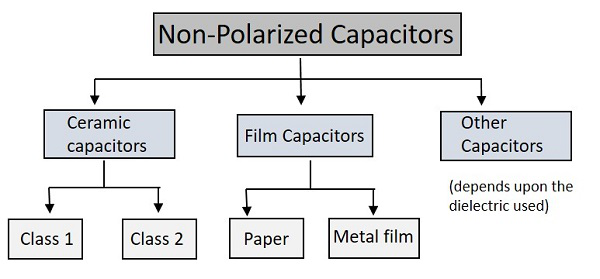
Among the types of capacitors, let us first go through the Ceramic Capacitors.
Ceramic Capacitors
The common capacitors used among fixed type are Ceramic Capacitors. The Ceramic capacitors are fixed capacitors that have ceramic material as a dielectric.
These ceramic capacitors are further classified as class1 and class2 depending upon their applications. For instance, Class1 has high stability and works best for resonant circuit applications, while class2 has high efficiency and gives its best for coupling applications.
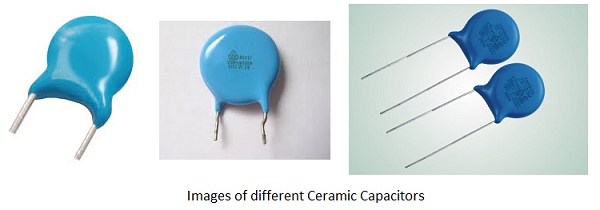
A hollow tubular or plate like ceramic material such as titanium dioxide and barium titanate is coated with a deposition of silver compound on both walls, so that both sides act as two capacitor plates and ceramic acts as a dielectric. Leads are drawn from these two surfaces and this whole assembly is encapsulated in a moisture-proof coating.
The most often used modern ceramic capacitors are Multi-Layer Chip Capacitors (MLCC). These capacitors are made in surface mounted technology and are mostly used due to their small size. These are available in the order of 1F to 100F.
Film Capacitors
The Film Capacitors are the ones which have a film substance as a dielectric material. Depending upon the type of film used, these are classified as Paper and Metal film capacitors.
These film capacitors are both paper dielectric capacitors whereas a paper capacitor uses a waxed paper while a metallic film capacitor uses a metallized paper. The arrangement is almost same as shown below.
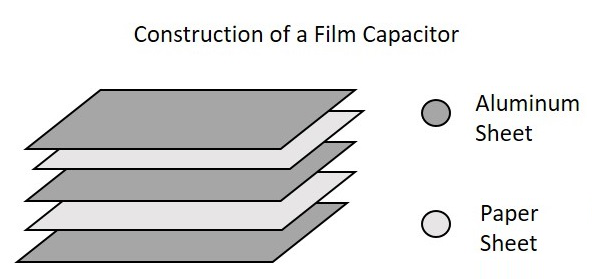
Paper Capacitors
Paper capacitors use Paper as a dielectric material. Two thin tin foil sheets are taken and placed between thin waxed or oiled paper sheets. This paper acts as a dielectric. Now-a-days paper is being replaced by plastic.
These sheets are sandwiched and are rolled into a cylindrical shape and encapsulated in a plastic enclosure. Leads are drawn out. The following figure shows an example of Paper Capacitors.
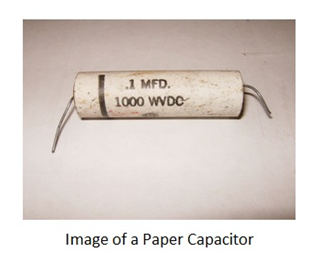
Paper capacitors are available in the order of 0.001F to 2F and the voltage rating can be as high as 2000volts. These capacitors are useful in high voltage and current applications.
Metal Film Capacitors
Metal Film capacitors are another type of film capacitors. These are also called as Metal Foil Capacitors or Metallized Paper Capacitors as the dielectric used here is a paper coated with metallic film.
Unlike in paper capacitors, a film of Aluminum or Zinc is coated on a paper to form a dielectric in this metallic film capacitors. Instead of Aluminum sheets placing between papers, the paper itself is directly coated here. This reduces the size of the capacitor.
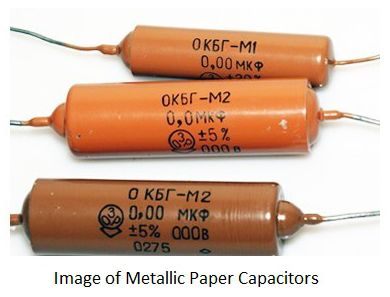
The Aluminum coating is preferred over zinc coating so as to avoid destruction of capacitor due to chemical reduction. The Aluminum coated sheets are rolled in the form of a cylinder and leads are taken. This whole thing is encapsulated with wax or plastic resin to protect the capacitor. These capacitors are useful in high voltage and current applications.
Other Capacitors
These are the miscellaneous capacitors that are named after the dielectric materials used. This group includes Mica Capacitors, Air Capacitors, Vacuum Capacitors and Glass Capacitors etc.
Mica Capacitors
The Mica Capacitors are made by using thin Mica sheets as dielectric materials. Just like paper capacitors, thin metal sheets are sandwiched with mica sheets in between. Finally the layers of metal sheets are connected at both ends and two leads are formed. Then the whole assembly is enclosed in plastic Bakelite capsule. The following image shows how a Mica capacitor looks like.
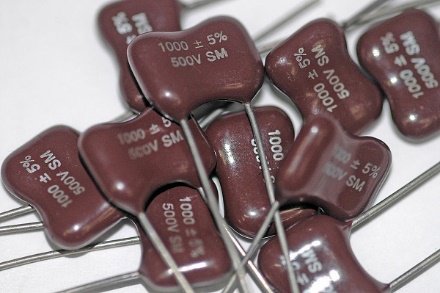
Mica Capacitors are available in the range of 50pF to 500pF. The Mica capacitors have high working voltage up to 500volts. These are most commonly used capacitors for electronic circuits such as ripple filters, Resonant circuits, Coupling circuits and high power, high current RF broadcast transmitters.
Air Capacitors
The Air Capacitors are the ones with air as dielectric. The simplest air capacitors are the ones with conducting plates having air in between. This construction is exactly the same as the variable tuning capacitor discussed above. These capacitors can be fixed and variable also but fixed are very rarely used as there are others with superior characteristics.
Vacuum Capacitors
The Vacuum Capacitors uses high vacuum as dielectric instead of air or some other material. These are also available in fixed and variable modes. The construction of these capacitors is similar to vacuum tubes. They are mostly seen in the form of a glass cylinder which contain inter-meshed concentric cylinders.
The following image shows a variable vacuum capacitor.
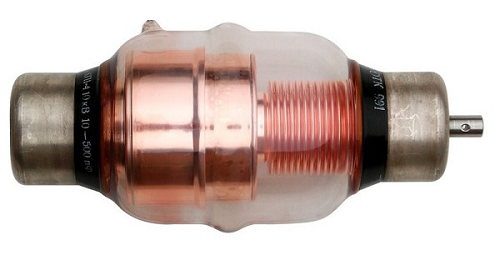
The following image shows how a fixed vacuum capacitor looks like −
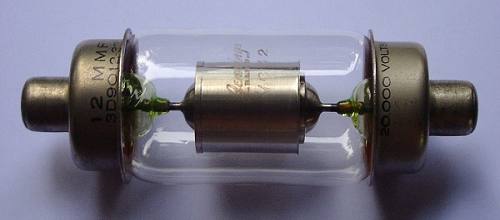
Variable vacuum capacitors are available at a range of 12pF to 5000pF and they are used for high voltage applications such as 5kV to 60kV. They are used in main equipment such as high power broadcast transmitters, RF amplifiers and large antenna tuners.
Glass Capacitors
Glass capacitors are very exclusive ones with many advantages and applications. As all of the above types, here glass is the dielectric substance. Along with glass dielectric, Aluminum electrodes are also present in these capacitors. Plastic encapsulation is done after taking out the leads. The leads can be axial leads or tubular leads.
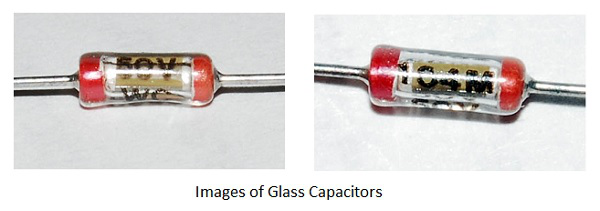
There are many advantages of a glass capacitor such as −
- The temperature coefficient is low.
- These are Noise-free capacitors.
- They produce high quality output with low loss.
- They have the capability of handling high operating temperatures.
- These capacitors can handle large RF currents.
There are many applications for these glass capacitors such as −
- Used in circuits that need to be at high temperature zones.
- Used in circuits that need high Q.
- Used in high power handling circuits.
- Used for circuits that need high tolerances.